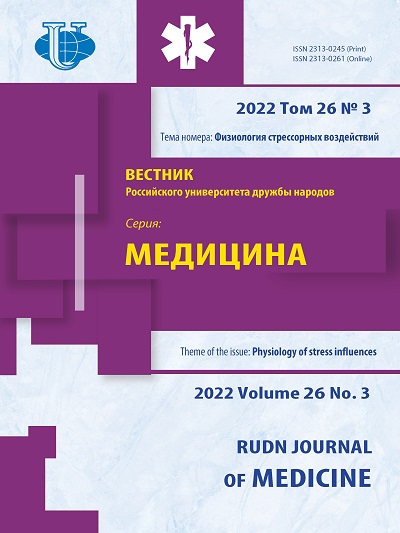Succinate dehydrogenase as a new target for melatonin binding in the complex diabetes mellitus treatment
- Authors: Elbekyan K.S.1, Markarova E.V.1, Unanyan L.S.2, Diskaeva E.I.1, Pervushin Y.V.1, Bidzhieva F.A.1
-
Affiliations:
- Stavropol State Medical University
- Russian-Armenian University
- Issue: Vol 26, No 3 (2022): PHYSIOLOGY OF STRESS INFLUENCES
- Pages: 221-231
- Section: PHYSIOLOGY OF STRESS INFLUENCES
- URL: https://journals.rudn.ru/medicine/article/view/32226
- DOI: https://doi.org/10.22363/2313-0245-2022-26-3-221-231
Cite item
Full Text
Abstract
Relevance. Alloxan, destroying the beta cells of the pancreas, provokes hyperglycemia, which causes a hypoenergetic state. Mitochondrial succinate dehydrogenase dysfunction plays an important role in the pathogenesis of diabetes. Pharmacotherapy of diabetes mellitus has been and remains the subject of numerous studies. Recently, the attention of researchers is increasingly attracted by the hormone of the pineal gland - melatonin, due to its biological and pharmacological properties. The aim of the study was to study the effect of melatonin on the activity of succinate dehydrogenase as a new target in experimental alloxan-induced diabetes mellitus. Materials and methods. The studies were carried out on male Wistar rats, with an average mass of 120-150 g, which were kept on a standard diet. The animals were divided into 4 groups. The control group was injected with saline solution, the second group was injected with melatonin at a dose of 1 mg/kg daily for 14 days, experimental diabetes in animals was simulated by intraperitoneal administration of alloxan at a dose of 150 mg/kg with diabetes. The fourth group of animals received melatonin on the background of alloxan. Succinate dehydrogenase activity was determined in liver and pancreatic tissues by photometric method. For the docking analysis, the AutoDock Vina and AutoDock Tools software packages were used. Results and Discussion. According to the results obtained, reciprocal relationships arise under the influence of alloxan in the activity of SDH in the liver and pancreas. Alloxan causes an increase in the activity of SDH in the liver by 1.9 times, and in the pancreatic tissue there is a significant decrease - by 5 times. The use of melatonin for animals with alloxan diabetes led to a decrease in the activity of succinate dehydrogenase in the liver by one and a half times in comparison with the indicators of rats with alloxan diabetes. In the pancreas, on the contrary, the activity of the enzyme increased by 3.3 times, which may indicate the restoration of the function of Langerhans beta cells. Conclusion. Melatonin blocking succinate dehydrogenase domain A reduces the hyperactivity of the enzyme in the liver, and in the pancreas through its specific receptors (MR1 and MR2) present on the surface of the membranes of β- and α-cells directly interferes with the function of the cellular elements of the islets of Langerhans, restoring them.
About the authors
Karine S. Elbekyan
Stavropol State Medical University
Email: karinasgma@inbox.ru
ORCID iD: 0000-0003-2403-8663
Stavropol, Russian Federation
Evgenia V. Markarova
Stavropol State Medical University
Email: karinasgma@inbox.ru
Stavropol, Russian Federation
Lernik S. Unanyan
Russian-Armenian University
Email: karinasgma@inbox.ru
ORCID iD: 0000-0002-6913-0175
Yerevan, Armenia
Elena I. Diskaeva
Stavropol State Medical University
Email: karinasgma@inbox.ru
ORCID iD: 0000-0002-6095-7010
Stavropol, Russian Federation
Yurii V. Pervushin
Stavropol State Medical University
Email: karinasgma@inbox.ru
SPIN-code: 9557-0420
Stavropol, Russian Federation
Fatima A. Bidzhieva
Stavropol State Medical University
Author for correspondence.
Email: karinasgma@inbox.ru
Stavropol, Russian Federation
References
- Bidzhieva FA. Features of the course of experimental alloxan-induced diabetes mellitus and methods of its correction. Dissertation for Candidate of Medical Sciences: 1.5.4. Stavropol. 2021. (in Russian).
- Lee H, Jose PA. Coordinated Contribution of NADPH Oxidase- and Mitochondria-Derived Reactive Oxygen Species in Metabolic Syndrome and Its Implication in Renal Dysfunction. Front Pharmacol. 2021;12:670076. doi: 10.3389/fphar.2021.670076
- Pitocco D, ZaccardiF, Di Stasio E, Romitelli F, Santini SA, Zuppi C, Ghirlanda G. Oxidative stress, nitric oxide, and diabetes. Rev Diabet Stud. 2010;7(1):15—25. doi: 10.1900/RDS.2010.7.15
- Grinenko TN, Balluzek MF, Kvetnaya TV. Melatonin as a marker of the severity of structural and functional changes of the heart and blood vessels in metabolic syndrome. Clinical medicine. 2012;2:30—34. (in Russian).
- Koliaki C, Roden M. Hepatic energy metabolism in human diabetes mellitus, obesity and non-alcoholic fatty liver disease. Mol Cell Endocrinol. 2013;379(1—2):35—42. doi: 10.1016/j.mce.2013.06.002
- Gati MA, Semenova EV, Eprintsev AT. Functioning of glyoxylate cycle enzymes in rat liver cells under conditions of experimental diabetes. Organization and regulation of physiological and biochemical processes. 2013. Issue 15. pp. 53—59. (in Russian).
- Bin-Cheng Ren, Wen Zhang, Wei Zhang, Jian-Xing Ma, Fei Pei, Bu-Ying Li Melatonin attenuates aortic oxidative stress injury and apoptosis in STZ-diabetes rats by Notch1/Hes1 pathway. J Sterid Biochem Mol Biol. 2021 Sep; 212:105948. doi: 10.1016/j.jsbmb.2021.105948
- Arushanyan E.B. Universal therapeutic possibilities of melatonin. Clinical Medicine, No. 2, 2013. pp. 4—8. (in Russian).
- European convention for the protection of vertebrate animals used for experim. and other scientific purposes. coun. of Europe. Strasbourg, 1986. 53 p.
- Eshchenko N.D., Volsky G.G. Determination of succinate dehydrogenase activity. Methods of biochemical research. L: LSU, 1982. pp. 210—212. (in Russian).
- Ruth Huey, Garrett M Morris, Stefano Forli Using AutoDock 4 and Vina with AutoDockTools: A Tutorial. Scripps Research Institute Molecular Graphics Laboratory10550 N. Torrey Pines Rd. La Jolla, California 92037—1000USA 2012.
- Summerfield M. Programming in Python 3. Detailed guide. — Translated from English — St. Petersburg: Symbol Plus, 2009. 608 p. (in Russian).
- Gati Mohannad Abdulrazzak Gati, Fedorin D.N., Polyakova-Semenova N.D., Vashanov G.A., Eprintsev A.T. Physiological and biochemical mechanisms of adaptation of rats to the conditions of alloxan diabetes. Fundamental research. 2013. No. 1. — pp.1256—1262. (in Russian).
- Katz LS, Baumel-Alterzon S. Adaptive and maladaptive roles for ChREBP in the liver and pancreatic islets. J Biol Che. 2021;296:100623. doi: 10.1016/j.jbc.2021.100623
- Uyeda K. Carbohydrate responsive element-binding protein (ChREBP): a key regulator of glucose metabolism and fat storage. Biochem Pharmacol. 2002;63(12):2075—80. doi: 10.1016/s0006-2952(02)01012-2
- Iizuka K. The Roles of Carbohydrate Response Element Binding Protein in the Relationship between Carbohydrate Intake and Diseases. Int J Mol Sci. 2021;22(21):12058 doi: 10.3390/ijms222112058
- Postic C, Dentin R, Denechaud P, Girard J. ChREBP, a transcriptional regulator of glucose and lipid metabolism. Annu Rev Nutr. 2007;27:179—92. doi: 10.1146/annurev.nutr.27.061406.093618
- Lee S, Xu H, Van Vleck A, Mawla AM, Mao Li A, Ye J, Huising MO, Annes J.P. Annes β-Cell Succinate Dehydrogenase Deficiency Triggers Metabolic Dysfunction and Insulinopenic Diabetes. Diabetes. 2022 Apr 26; doi: 10.2337 /db21—0834
- Brière JJ, Favier J, Ghouzzi VE, Djouadi F, Bénit P, Gimenez AP, Rustin P. Succinate dehydrogenase deficiency in human. Cellular and Molecular Life Sciences 2005; 62:2317—2324. doi.org/10.1007/s00018-005-5237-6
- Fu Z, Gilbert ER, Liu D. Regulation of insulin synthesis and secretion and pancreatic Beta-cell dysfunction in diabetes. Curr Diabetes Rev. 2013;9(1):25—53.
- Kanamoto R, Su Y, Pitot HC. Effects of glucose, insulin, and cAMP on transcription of the serine dehydratase gene in rat liver. Arch Biochem Biophys. 1991;288(2):562—6. doi: 10.1016/0003—9861(91)90236-c
















